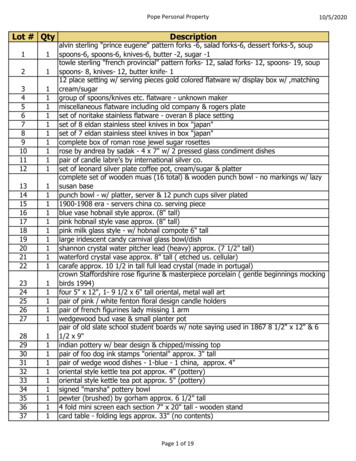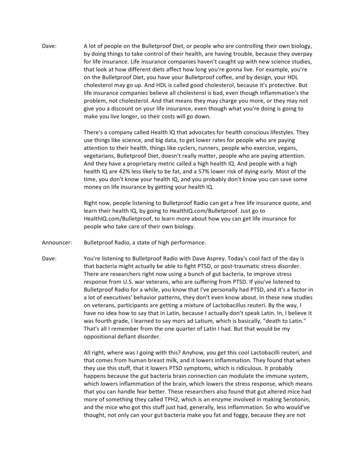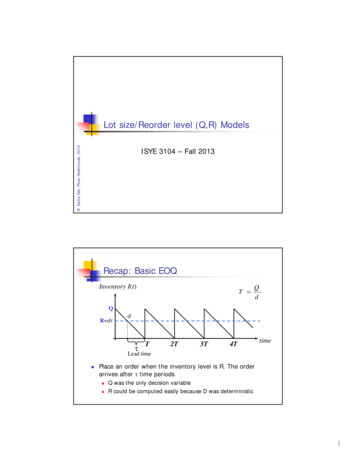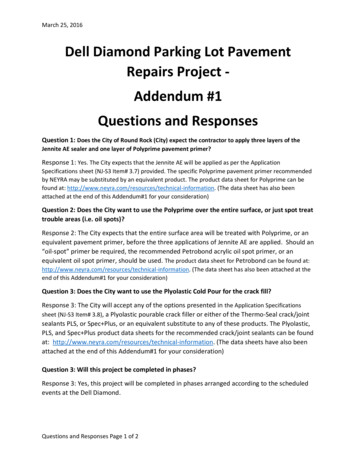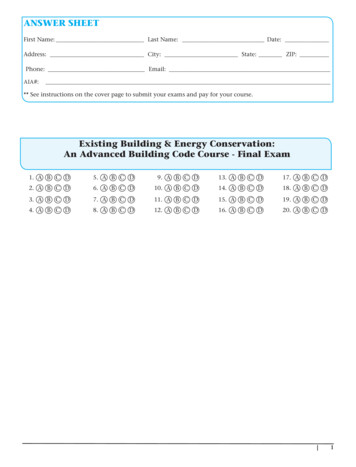
Transcription
Building polyhedra and a lot of other related structures usingdouble-sided concave hexagonal origami units.Francesco De ComitéUniversity of Sciences of LilleAbstractModular origami is a branch of origami where one can build complex structures by interlockingelementary folded units (the modules). We will explore the possibilities of one of those modules, anshow it can be used in a wide range of different constructions, sometimes by infringing the rules ofpure origami (no glue, no scissors, no graduated ruler).IntroductionA lot of different units have have been proposed by several origamists. The double-sided concavehexagonal ring solid unit was introduced by Tomoko Fuse in her book « Unit PolyhedronOrigami ».She used it to build several archimedean solids (and one platonician solid : the dodecahedron).In allof those solids, the hexagonal module plays the role of the edge, hence only one size of unit isneeded (all vertices in platonician and archimedean polyhedra are equals).We will show that we can play with colours to exhibit some properties of those solids (hamiltoniancircuits) and that we can build a large set of related solids (fullerenes, nanotubes, Johnson solids).Then we will show that we can use units of different sizes to widen the set of buildable solids(Catalan polyhedra, Penrose tiling-like balls).Folding a hexagonal moduleThe table on page 2 shows how to fold an elementary unit. The relative sizes of the rectangle sidesis not really important, we will see later that they are to be within certain limits. A standard ration is1:2, easy to obtain by cutting a standard square sheet of paper.The module has two flaps and two pockets, that will be used to connect several modules together.(see Illustration 1: Flaps and pockets) . Table 1: Joiningmodules on page 3 shows how to link two or moremodules together into a closed ring. Of course, you canlink more than three modules : it's not rare to link five orsix modules together without problems.Even if pure origami prohibits the use of glue, a little bitof stick glue can help avoiding the structure you build tofall apart when a lot of modules are already connected: itlet the user concentrate on the geometry of his/her work.What can we build with such units ? Plasticity constraintsmake it difficult to build platonician solids, except theIllustration 1: Flaps and pocketsdodecahedron. But quite all the archimedean solids can bebuild (to be verified.). An illustrated catalogue of possibilities is detailed at chapter Objects youcan build on page 3. Construction is often easier when the modules are made longer, by increasingthe ratio length:width of the initial rectangle.
Begin with a rectangleFold it twice in twoClose itFold the corner at 45 Fold the bottom at 22,5 Idem on the other sideUnfold everythingRaise the lower right crease.as in this pictureSame on the other sideMark the creasesMark the creasesUntil you obtain thisFold in the middleFold the left loose endLike thatSame on the rightFold the two upper triangles18 steps for folding a module
Insert a flap in a pocket Insert the little triangle Mark the creasesin the other part of the firmly.pocket.Continue with anothermodule and close thering.Table 1: Joining modulesObjects you can buildPlatonician solidsAs said above, physical constraints make it difficult, if not impossible, to build any of the regularsolids except the dodecahedron.Illustration 2 and 3 show two versions of the dodecahedron, with different sizes for the edges.Archimedean solidsHere again, the only limit are the physical rules of the real world. One thing that makes modularorigami interesting is how you can feel in your hands the physical constraints, when you try toassemble modules which don't want to meet each other !I never studied rigorously which solid one can assemble or not. Illustrations 4 to 7 demonstrate that
Illustration 6: Truncated octahedronIllustration 7: Snub dodecahedronat least 4 of them are possible. Illustration 5 shows an interesting feature : the purple edges arefollowing a hamiltonian path on the surface of the rhombicosidodecahedron. Even if we know thatevery archimedean solid has a hamiltonian path, it is not easy to find. But once you got one,building the corresponding modular solid is quite easy, and give you an illustrative mathematicalmodel at no cost.FullerenesSince fullerenes are based on regular polygons (pentagons and hexagons), they are also candidatesfor a modular origami construction. If nanotubes are easy to build, a new physical reality imposesits law : gravity. Big models begin to be heavy, and can overcome the strength of the paper. Asolution is either to make thinner edges, or to make smaller models. The second solution should bebetter, since the weight of an edge varies like the third power of its size. Another limiting factor ishuman : patience. But planning to build huge models can be the occasion to define a team work !Illustration 9: A short nanotubeIllustration 8: Fullerene C240
In general, it's not a good idea to build separately big parts of the model and join them together atthe end : big parts are heavy, and the flaps are fragile. Trying to assemble big parts often results indamaging the flaps and pockets one try to assemble all at the same time. By experience, it's better tohave one construction, where one add modules one by one. This implies to have clearly in mind thegeometry of the object. Using different colours might help.Penrose-like tilingMy first idea was to use hexagonal units to build planar Penrose tilings, which can be made withedges all of the same size. But, while making my first experiment, I realized that the structure I wasbuilding is not at all planar. This is due to the fact that both parts of an edge are not of the same size.But every structure that has a five-fold symmetry can be put on the faces of a dodecahedron toproduce a spatial symmetric structure. I was then able to recycle my Penrose tiling into a quitecomplex three-dimensional object.Illustration 10: A simple Penrose-likestructure. The five-fold motif is clearlyvisible.Illustration 11: A more complicatedPenrose-like tiling : can you find themotif ?Illustration 13: A big Penrose-like tilingThe model in Illustration 12 is at the limit of heavinessproblem : while it poses no problem during theconstruction (apart from patience), it is beginning tocollapse under its own weight.Illustration 12: A four-fold motif on acubic symmetry
Modules of different sizesThe geometry and measures of the moduleIllustration 14: Naming the creases and their measures and anglesThe illustration above shows an unfolded unit. When folded, the unit has three important measures :a, b, and l/4. When we work with equal units, we don't matter too much about those quantities,except for controlling the thickness of the edges (namely l/4). If we want to design and work withedges of different sizes, we have to control those values. Since we want the units to join perfectly,we must maintain the same value of l/4, for each size of module: hence the length of modules willnot change. The only thing we can modify then is h, the height of the rectangle. How a and b arerelated to h ? Some elementary trigonometry is necessary :a h 2utan u u 4u 8LL4L Ltan 2 1 484La h 2 1 2Following the same logic, it is easy to express b as a function of h and L :b h L 2 1
This last formula gives the minimal value of h, since b must be non-negative.Then if we want two different units of respective length a 1 and a 2 , such that a 2 k a1and a 1 is known, we must set h 2 to :Lh 2 k h1 2 1 k 1 2Units of different sizes : applicationThe Catalan solids are the dual of the archimedean solids. All their faces are equal, but the length oftheir edges are different. As for the archimedean polyhedra, it is possible to build a large part of theCatalan solids set.Illustration 15: Kite hexecontahedronIllustration 16: PentagonalhexecontahedronIllustration 15: Kite hexecontahedron And Illustration 16: Pentagonal hexecontahedron show twoexamples of modular structures build on this principle. The exact dimensions of the edges can befound in any good geometry book, or on the internet, and is left to the reader.One can also decide to build those polyhedra not byshowing their edges, but different paths from one verticeto the “center” of the face (this center can be defined indifferent ways). This leads to still another rich variation,which is illustrated on Illustration 17: Pentagonalhexecontahedron variation, based on the geometry of thepentagonal hexecontahedron. Note that this variation isalso appliable to the archimedean solids, and since one canchoose its own definition of the “center” of a face, it givesraise to an infinity of variations, which might be worthtrying virtually before to begin folding.Illustration 17: Pentagonalhexecontahedron variationConclusionThe hexagonal concave unit is an easy to fold easy to assemble modular origami unit, which allowsto build sophisticated geometric structures, from standard polyhedra to more exotic ones. With alittle patience, one can obtain real-world objects, lead tangible experiments at the fraction of thecost and work implied by standard model making, like 3D printing, for example. It can be used inclassrooms, since the need of a lot of modules can make the folding a group activity, and I think it'svaluable for children to be able to conduct an experiment from the very beginning (imagine thestructure), then the construction itself ( fold the paper) and the final result (assemble the units).
Modular origami is a branch of origami where one can build complex structures by interlocking elementary folded units (the modules). We will explore the possibilities of one of those modules, an show it can be used in a wide range of different constructions, sometimes by infringing the rules of pure origami (no glue, no scissors, no graduated ruler). Introduction A lot of different units have .


